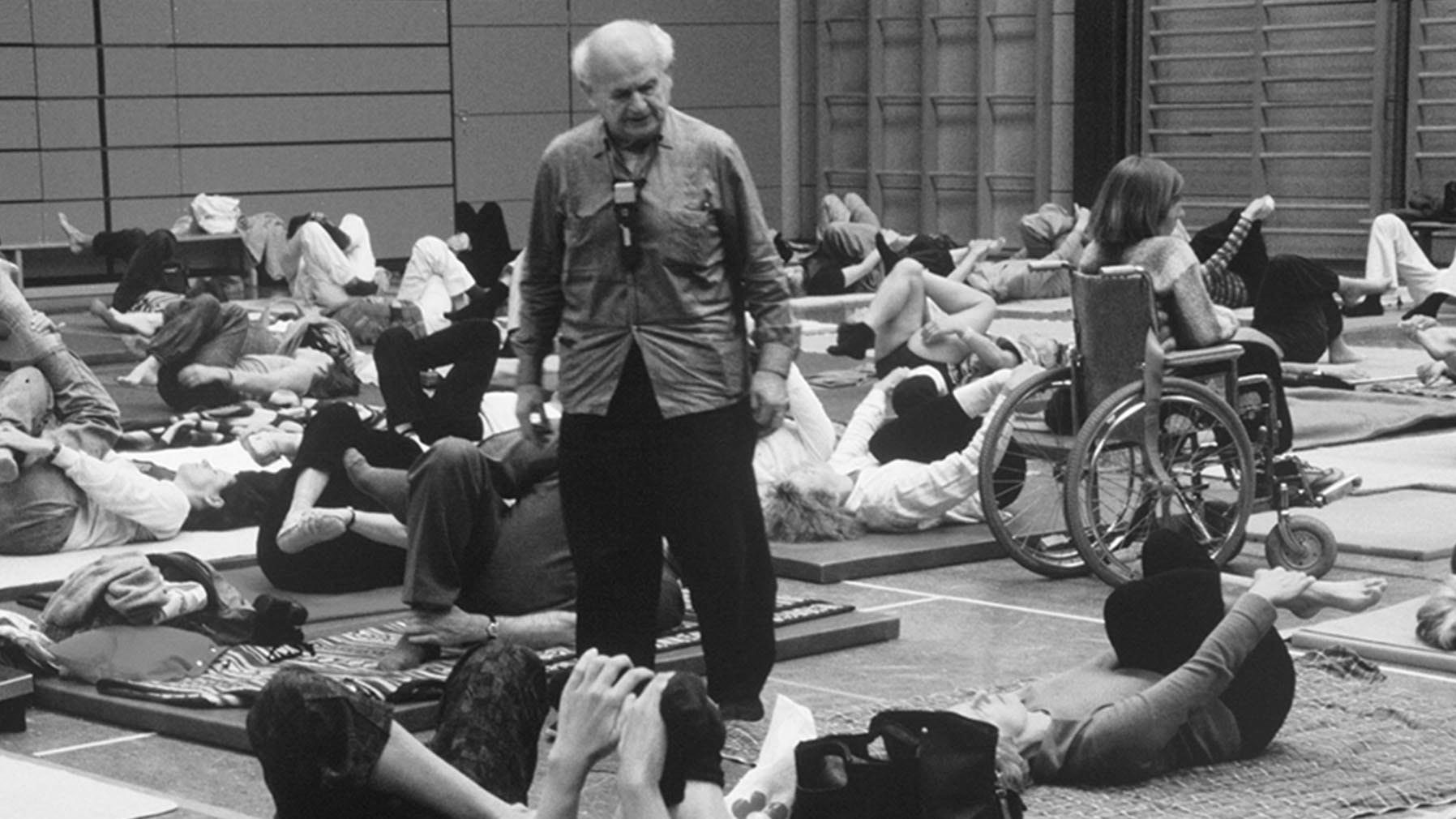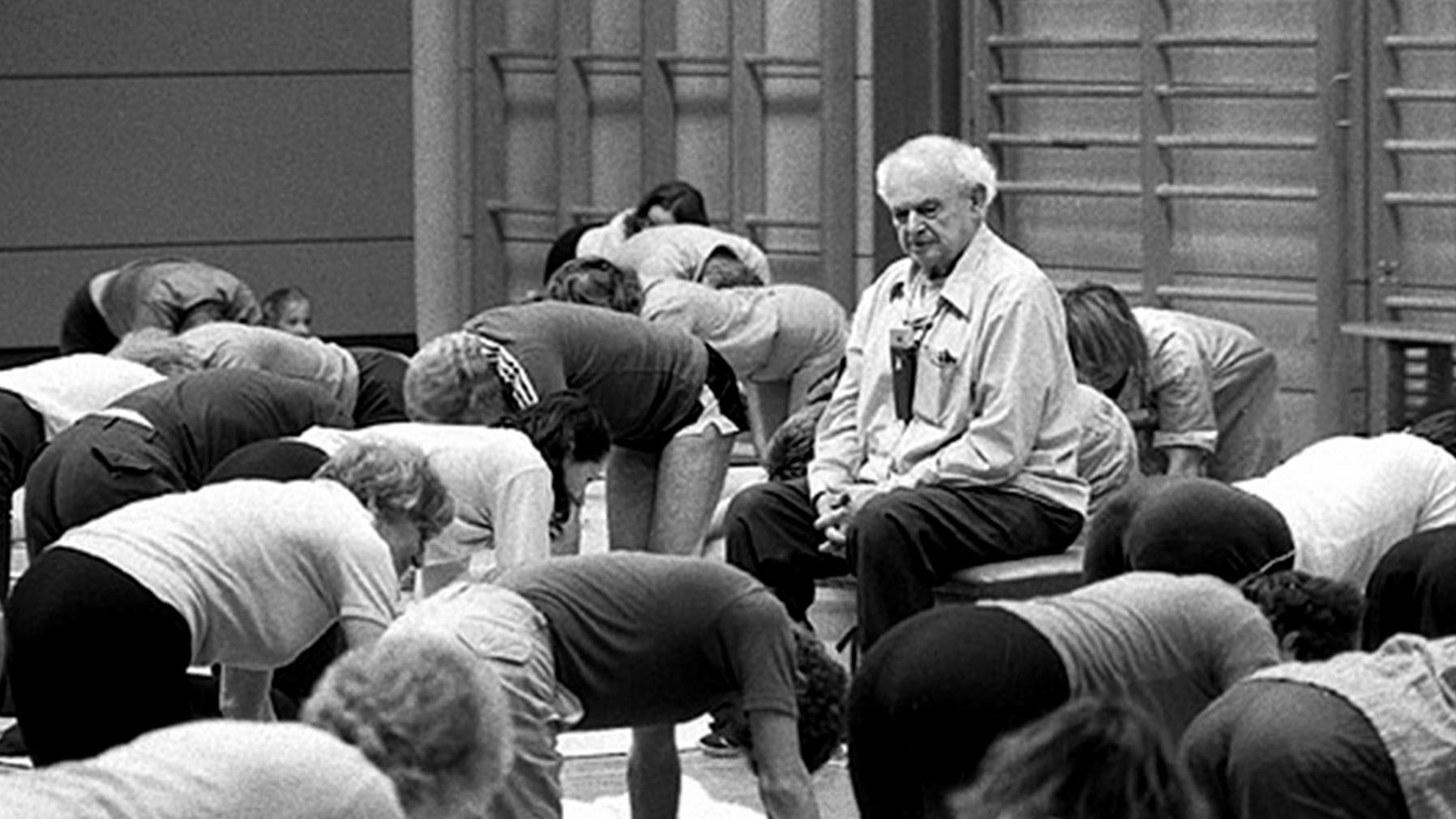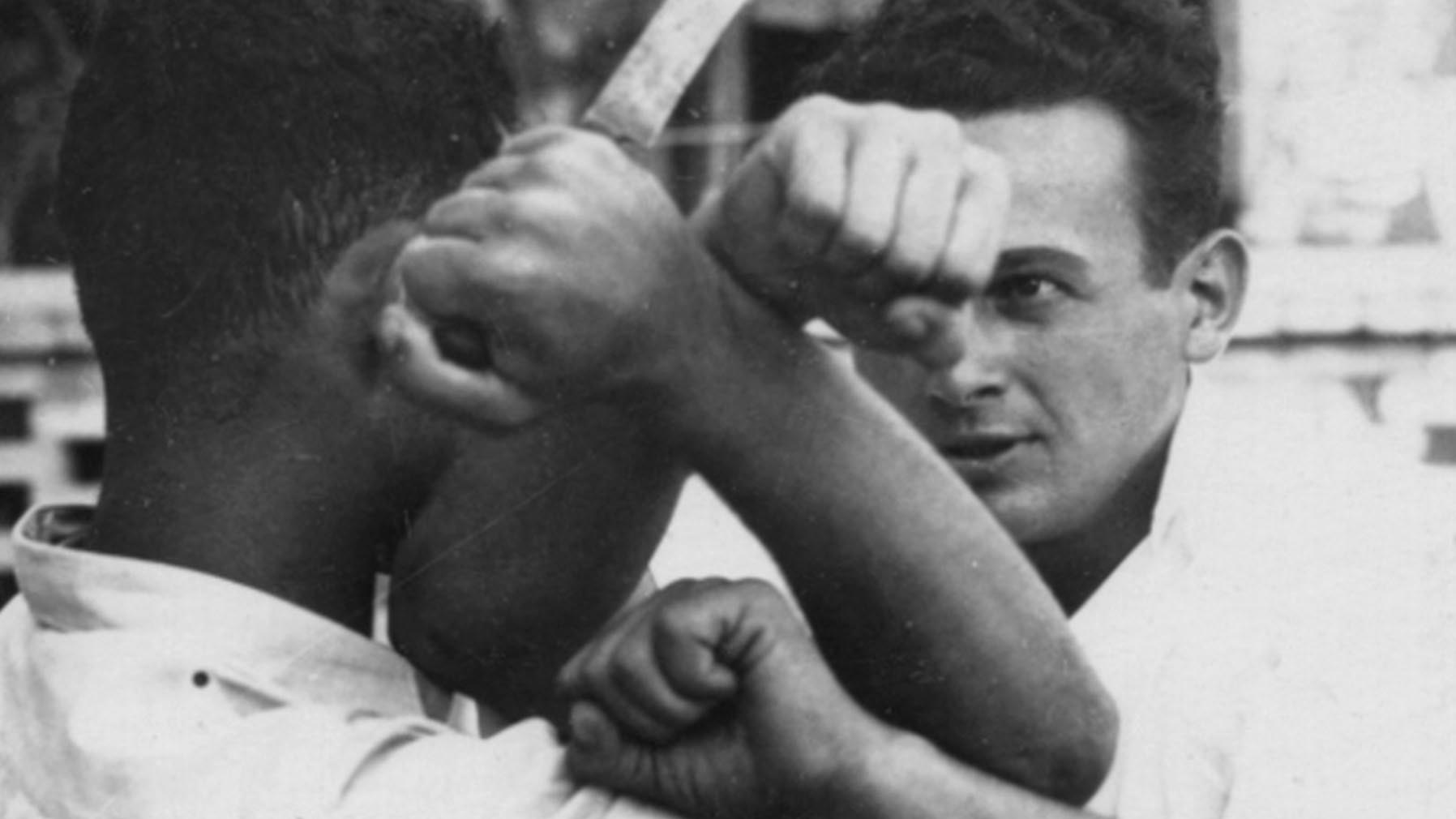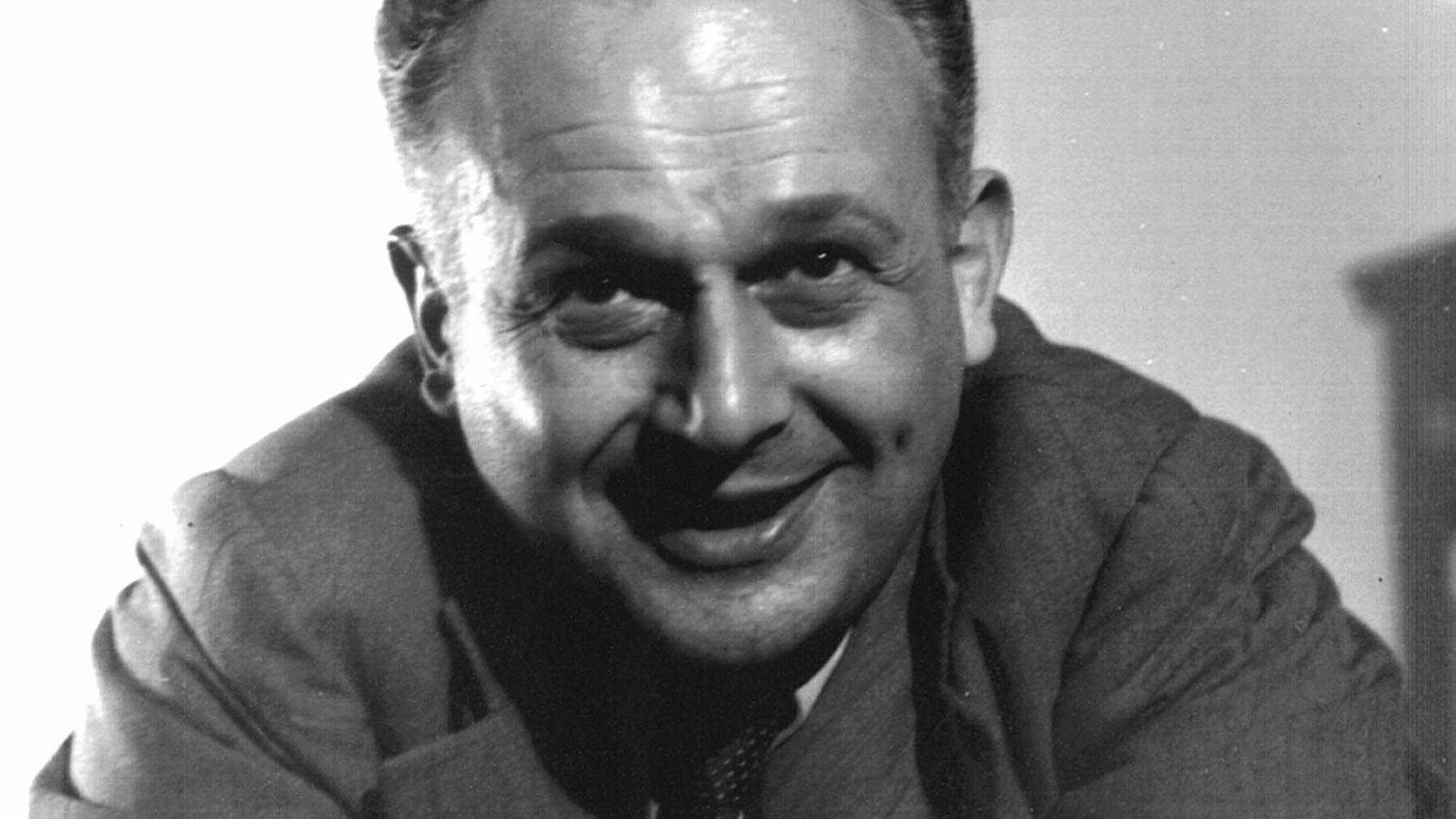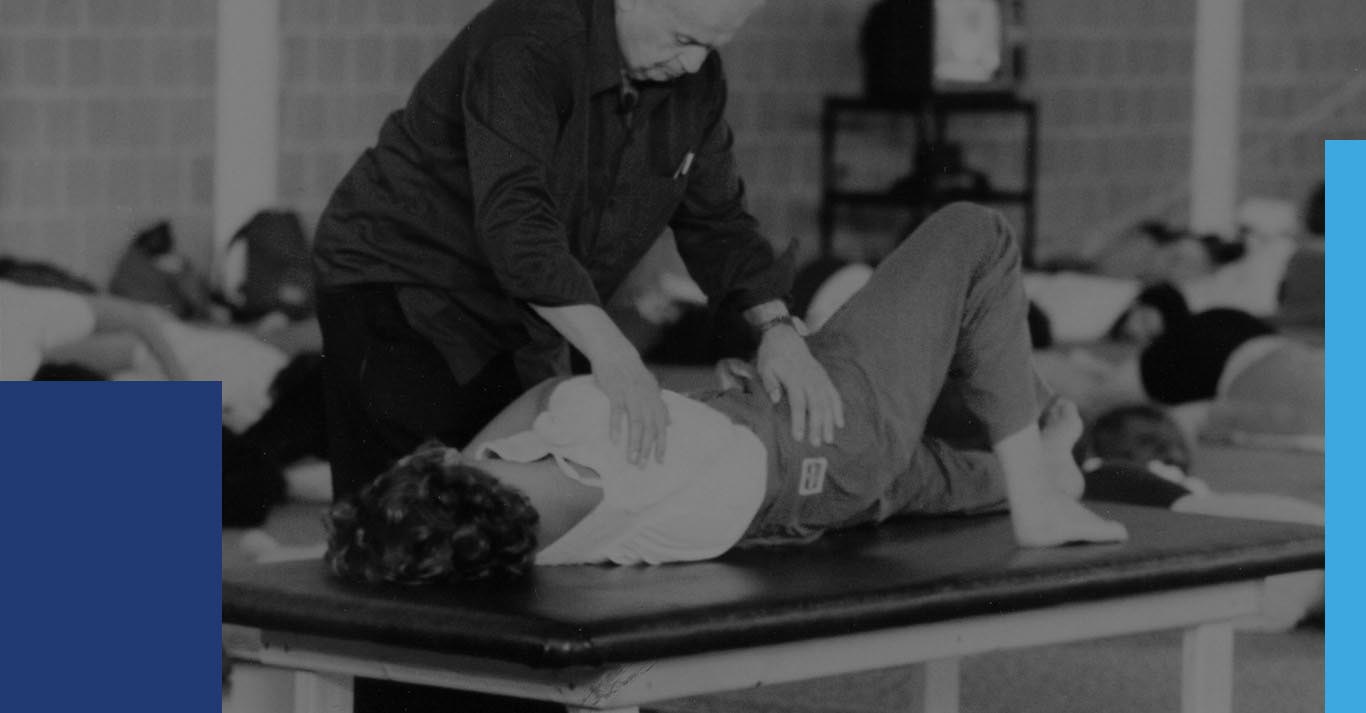
Movement is life.
Life is a process. Improve the quality of the process and you improve the quality of life itself.”
Moshé Feldenkrais
Therapeutic effect of the
Feldenkrais method
Ewa Paszkowska - Demidowska
Movement as an access code to the brain. Perhaps the only tool that is available to us for continuous self-development, self-improvement and, consequently, self-healing. But in order for the movement to function in this way, it should be done with the consciousness of the changes taking place in us. And not only on an intellectual level – I know how it works, and what happens to me when I do some movement – but at the level of the sensual, emotional zones, deep levels of the subconscious and the unconscious zone. The movement of the small toe of the right foot is not only to spend energy to move your sock on your foot, just to make sure that I am this toe and foot and to be able to register the whole avalanche of changes that occur in the microsystem that we are . At all its levels, we can consciously record changes that occur on the surface of the cell membrane of each individual cell of our body. Because the motion resonates, leads to changes not only in the mechanics and chemistry of our microsystem, but perhaps it resonates with a force capable of changing our DNA. The movement that is performed resonates, cooperates also with the outside world, affecting other microsystems and, therefore, is a tool not only to a constant change of oneself, but also to influence the world around us. We are also affected by all the changes that are taking place in the world.
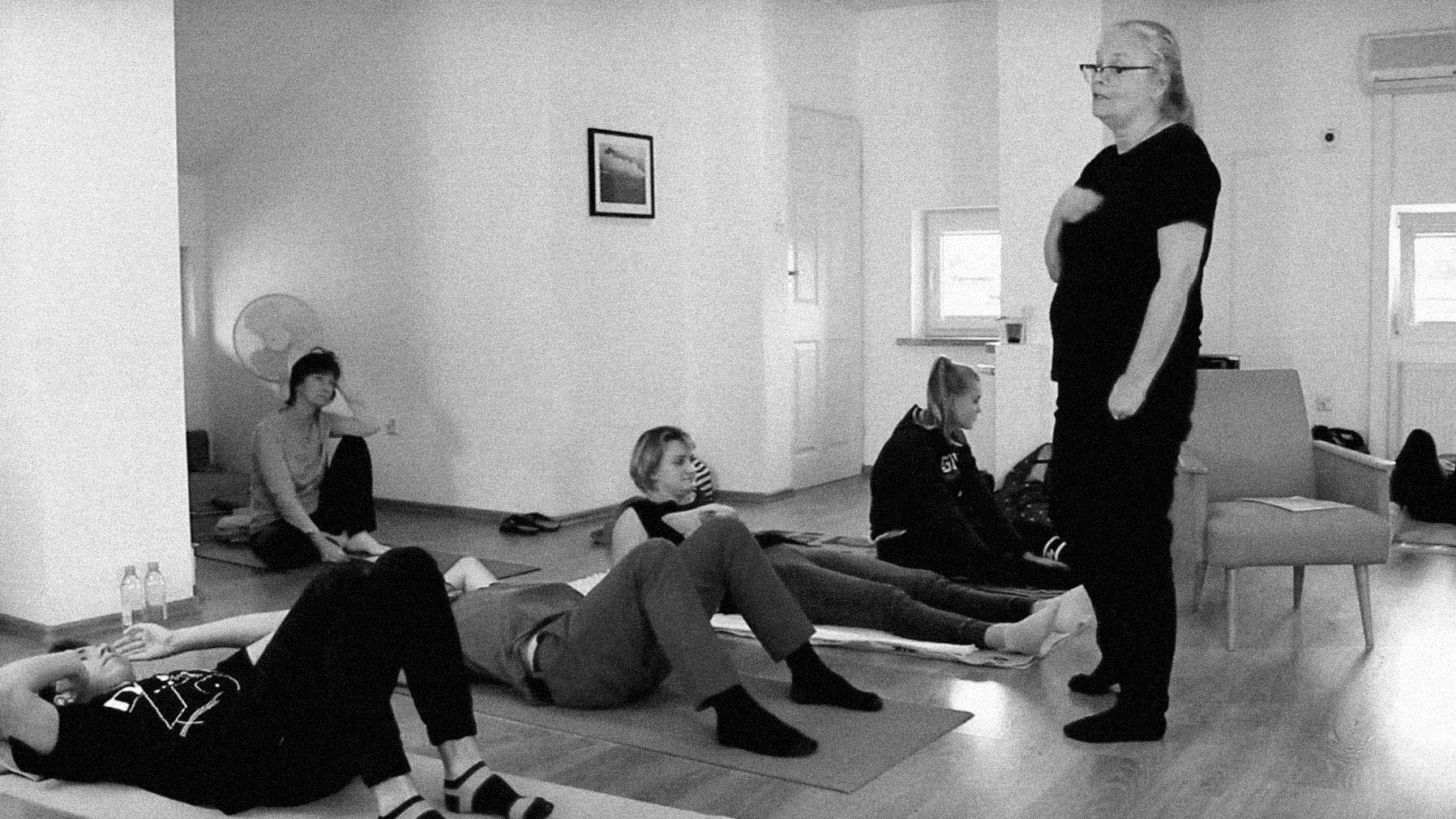
Movement in the ordinary sense is a purposeful movement, that is, a situation where the movement itself does not matter, because our mind is directed towards the goal. A goal that is important to us. Even if it is sports training, or gymnastics – movement is a means to increase motor capacity, increase the level of serviceability. The same goes for the movement, we do it without realizing it. You are reading this text by moving the eyeballs – and therefore the muscles do the work, but you are not registering this work, because you do not notice the movement of the lips, the tongue ….., all this happens automatically – such a movement of perpetuation, , stiffness or even damage to your patterns and motor habits, your image and the meaning of who you are. The therapeutic power of change has no movement for any purpose, on a contrary it involves movement as an trigger for modernization, change, and constant development of oneself. The movement is only a trigger, because the goal is to feel oneself more. Constant learning, recognizing oneself at different levels during the exercise. The movement turns into a tool for us, so that we write new data about ourselves in our brain. Just like we did from the first moments of our life.
And since we are no longer children, we have certain motor habits, fixed and unchanged for many years, tension, spasticity and damage – so slow movement turns into therapy here. First, the tool for diagnosing ourselves, in order to determine the goal, where the damage is, when the pain passes, the tension, how to use the movement gently, smoothly instead of fighting the pain of the spastic movement, and after which the movement becomes a medicine. Treatment is a process of disintegration, putting out the old motor habit and integration, thereby creating a new room in this. So the life did not hurt. Similar, and perhaps even more effective is the movement, that we only feel, without the need of conscious carrying it out. So, the movement done by the teacher (therapist) that moves our bones, and we just feel and register our strength to apply the changes at all levels of our being.
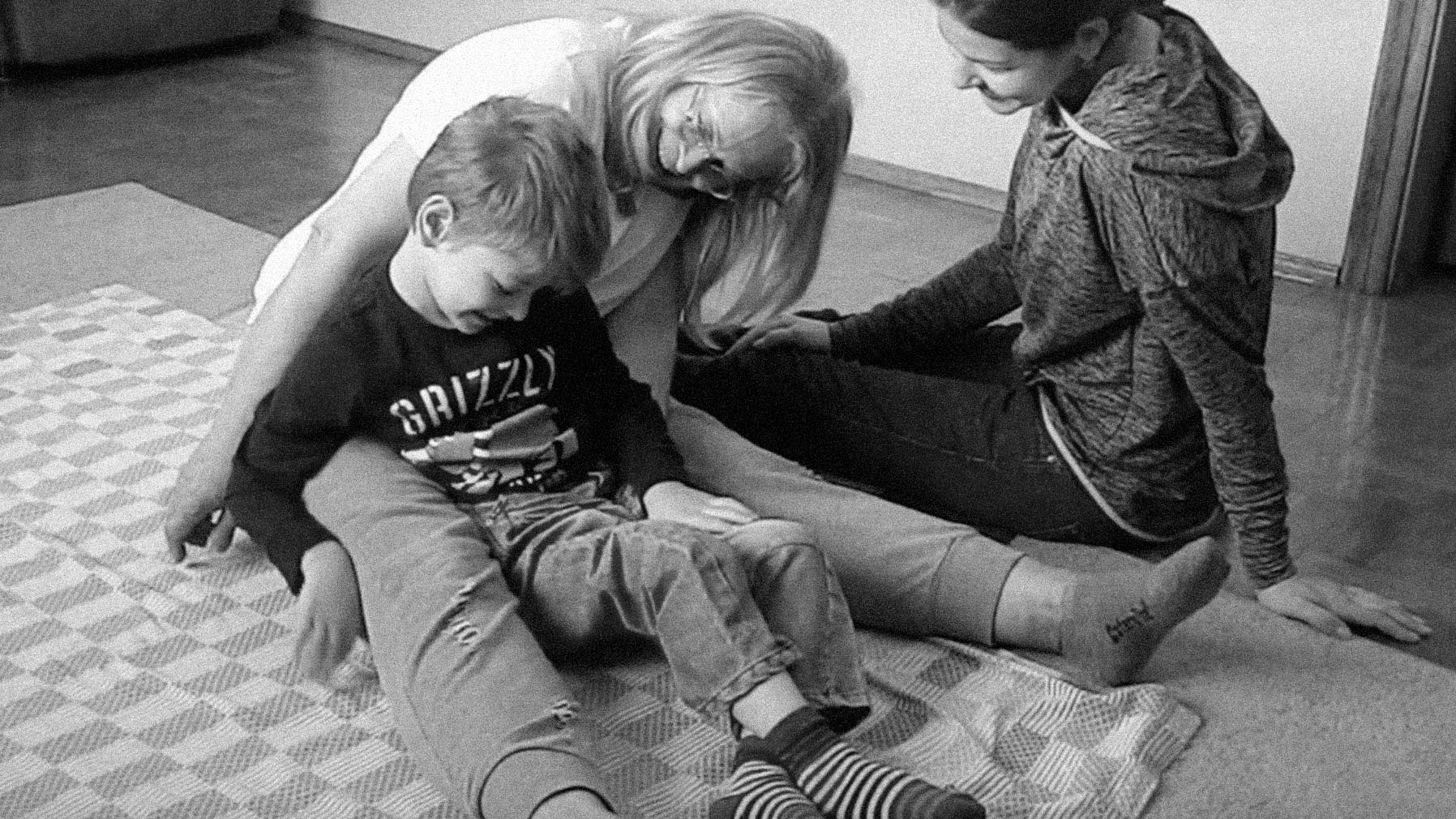
But for this to happen, it is important to know how and why the teacher moves us. Why does our body move? If we do so to correct ourselves,properly change us, adjust our bodies to ideas about who we should be and how we should move – this action will be different. There is a risk that our nervous system can recognize them as an attack, a form of undesirable interference, and begin a defensive response. Then the action can be the cause of regress.
Instead of improving, there can be a deterioration. In the case of brain damage, the reaction may be in increasing spasticity and increasing bastard movements. If the teacher moves our body, and the movement does just a trigger role – and only when you do it just to give yourself an opportunity to feel who you are and how you change at each stage, then you can recognize what is good for you, and what harms you, when you have a sense of well-being and when discomfort or pain disappears. If during this lesson we do not recognize that the touch is threatening us, but acting as a strengthening and development – then the lesson is the beginning of the process of self-regulation. The nervous system, in order to be able to change, must know what to look for.
Lessons are the way in which the nervous system recognizes and knows what to look for to improve the quality of life of the host Because it is wise, and the survival instinct is its main principle. Lessons are also needed to ensure that our nervous system / which we are at the level of each cell of our body / is able to distinguish what is ours from what is superimposed on us in the development process. What we need, from what we just use to do harm.
This is our lighthouse for the ship at sea. If the nervous system recognizes and registers that the body should not hurt, and the movement can take place without effort – then you will know what to look for. But to be able to search – the system should know that this is possible. Therefore, movement is light in the tunnel, so the brain knows what to look for. The beginning of self- improvement, self- development, self-healing process.
The process takes time, sometimes erases old data about yourself and brings together new information about who we are or first of all, we constantly become. It is a process of continuous disintegration – but all what appears – whether at the level of movement or emotion – it is our own, it comes from our innards and our center. And it is not given to us, not introduced or coded in our therapy. The method works this way. This is available to all of us, regardless of our place in the time scale of life, on which we constantly live.
Moshé Feldenkrais
Oleg Pawliszcze
There are too much biographical notes on him to duplicate them on this site. Let us just know that this son of woodcutter and grandson of a famous tzadikus started his life path from birth in present-day Ukraine in 1904 and ended it in Tel Aviv in 1984. His 80 years of life may have to be called a life comparable to mystics and visionaries, which would create an aura of miracle worker and master around him, confirmed by his uncomparable properties .. We honestly doubt that he was the protagonist of this note fancied to leave so marble memories about himself, considering the content of his work, that of the innumerable activity is the reason we now speak to you and act as practitioners and therapists.
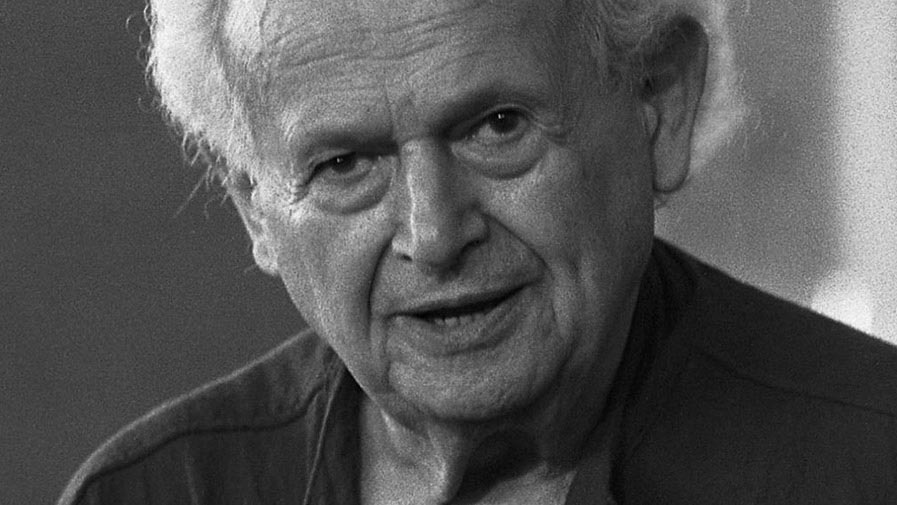
A renaissance man developing his scientific and physical activities in the era of inhuman wars carried out on an industrial scale. A disciple of Marie Slodowska – Curie, Jigoro Kano and other people who became legends, today seems to have achieved many, often difficult to combine aims in one life. Implementing a truly Platonic ideal of development kalos- kagatos (beautiful [strong] and wise) Moshe touched potentials in both fields, gaining the title of engineer, developing thread of inventions in the field of physics, parallelly making perfecting vessel and weapons of his body through studying ju-jutsu and judo from the founder of the latter martial art.
Learning is better
than curing"
Moshé Feldenkrais
Many rest on the golden couch in the middle of what our hero did within barely three decades, without showing any intention of stopping the development. His creative restlessness, however, was connected with something that culminated in his work and life, demonstrating a quality that turned out to be something as innovative as obvious and perhaps this was the reason it remained unnoticed in his days. But to do so, the Moshe’s development had to be disturbed by the fall, so that he could draw his attention to the source of all discoveries – himself. In his case this was a knee injury, preventing him from training martial arts, generating a stopping point in his rushing development on many fields. The fact that it was body that provided him with the necessary focus, influenced that from a wide range of his activities, this Da Vinci of the twentieth century focused primarily on what he most had missed – the motor functions.
In a previously unprecedented (or forgotten) way in the West, he began to notice the extent to which rehabilitation methods based on training body through often painful and invasive methods, surprisingly ignore natural vectors of movement generation, are self killing activities. They made the treatment require huge amount of energy and suffering for the body, stimulating a will to escape from activity rather than its continuation and deepening.
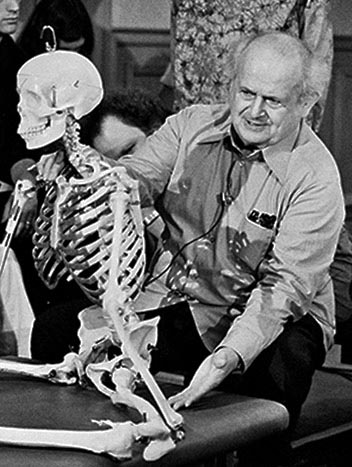
As one of the first in our part of the world, Moshe also noticed the totality of the human being. The fact that anything done with a man on one side of him has repercussions on the remaining parts, and raising awareness of one function in man causes raising awareness of his other aspects. This disenchanted the belief that man in its potential is physically, mentally and intellectually rather formless and not too wise being and when resiopectively directed from outside with careful and properly controlled intervention, is able to deliver its proper development.
This interference had to be, in the light of such conviction, a peculiar violation on this formlessness. Like tongs and a hammer towards iron.
As a physicist, Moshes experience with materials prevented him from directly implementing the blacksmith attitude to the matter of working with man through his body and intelligence. The way he went gave more light to respecting what other methodologies preferred to plasticize, thus violating the information encoded in that way. Respect for the wisdom of the body, movement, the structure of its foundation, the skeleton.

Changing the attitude vector towards the body and the whole person inevitably changed the response to that attitude. Man turned out to be an unknown treasury of self-evolving solutions and a constantly learning system – if you let it, if you let it speak. Opposing violent and intrusive methods, Moshe contrasted tem with trust to the nature of what the human mind perceives as a problem – disability, illness, motor limitations, discomfort.
This trust resulted in the knowledge of how these problems had lasted for years as messages in a language the recipient could not or refused to read. This opened an ocean of possibilities, in which each disease, or neurological, anatomical, or intellectual/mental obstacle can be used immediately as a message to obtain comfort and functionality. Interestingly, as an effortless, painless, pleasure-based, for pleasure is considered here a derivative and an efficiency test. Pleasure of the process, not the pleasure of the result, preceded by the gehenna of pain. Pain that rehabilitated children suffering from cerebral palsy, autism or other disabilities could not understand, which blocked them from faster progress in integration.
What has become a revolutionary change in the approach to rehabilitation and working with a man after the appearance of Dr. Moshe Feldenkrais is:
- Changing the perception phenomenon of the problem, from the enemy, or the opponent became a messenger, with encoded message to the man himself, and so a friend.
- Shifting focus from effect to process. By this, what is possible, at the same time, becomes a reward in itself both in the mind of a therapist and a patient.
- Focus on comfort and pleasure at work, naturally directed therapeutic toolkit on ergonomics, allowing no further damage to the patients or rehabilitation therapists.
- Respect for the initial potential, and therefore the abandoning the “blacksmith rehabilitator”, forcing the defective material to become something normal and becoming the patients student, thereby returning the elementary human dignity to him.
In such a short note, which is an introduction to the work method that is the content of our activity and passion (and to its creator) it is difficult to mention all the fascinating themes of life and ordinary genius of Moshe Feldenkrais. Perhaps that is why we prefer to concentrate on what the genius discovered. Namely, on the wisdom embodied in the human body, in matter and movement. Discovery as simple as the original. This refreshing and optimistic message frees us at the very beginning from the bag of stones that we carried so far in our intense antagonism towards ourselves and our physicality, believing it to be the only way to function.
But as Feldenkrais discovered, friendship and trust for oneself and our own intelligence, the will to hear ourselves and the humility to what we are are the factors that make this functionality not only accessible but also pleasant, elegant and durable.
The Feldenkrais Method
Alan Questel
The Feldenkrais Method is a unique approach to improving, developing and regaining human function. It is a therapy without being a therapy. It is an approach based on learning and has broad applications in the domains of neurological, skeletal and muscular challenges.
It is important to understand that the learning I am referring to is not our typical kind of learning. It’s not memorizing words or formulas nor learning techniques to apply to specific conditions. It is learning that occurs through experience. Learning that is based in the uniqueness of each individual, no matter what their diagnosis is. It is learning that leads to self-improvement and self-healing where the individual is able to generate and maintain changes on their own.
Developed by Dr. Moshe Feldenkrais. A physicist, engineer, mathematician, football player and one of the first westerners to get a black belt in Judo. When the medical profession was unable to offer him much help in the recovery of his knee injuries, Dr. Feldenkrais became his own laboratory. Through self- examination and study, he developed a systemic understanding of how our nervous system is the door to improvements in ourselves, in a non- invasive and continually improving fashion.
How can something be a therapy without being a therapy?
Its depends on the model through which someone views a difficulty. The more traditional ways of looking at things, a therapeutic point of view, sees a ‘problem’ and attempts to correct it. This works often enough that it continues as an approach to many issues. But what happens when it doesn’t work? Too often the patient is blamed for not doing enough, being resistant, too far gone. This is unfair to the person in need as well as to the professional working with them. Of course, this is done with the best of intentions, but it closes the door to the pursuit of further understanding and discovery that might potentially help someone. Yet some manage to improve beyond the expectations of their doctors and therapists. How does this happen?
This was some of the genius of Dr. Feldenkrais. In his approach, he came to understand how one of the major functions of our nervous system is learning, taking in and processing information. One that is connected not only to all of the other systems that exist within us but also is connected to and with the world outside of us. That we function as a system and no one place can be viewed as ‘a problem’ without taking into consideration the rest of the self and the environment it exists in.
The shift here is to the paradigm of learning. This is the context through which a difficulty can be viewed to create situations where new information can be taken in and utilized towards new ways of acting. Part of the shift here is in the ability to understand how a system works. How learning can happen in unpredictable ways. In understanding how small changes can, over time, lead to big differences. It revolves around a thinking that is inclusive rather than exclusive.
This is an interaction ‘with’ someone, not one that is done ‘on’ or ‘to’ someone. Most would think they are working with someone. But as in the Heisenberg Uncertainty Principle, the observer influences the experiment. Read on to do a little experiment to clarify this more.
This is the means to discovering what the individual needs in order to develop, rather than applying a formula or technique on a person.
Improving, developing and regaining human function.
Too often Improving, developing and regaining human function are seen as different things needing to be approached in different ways. But all human functions share particular characteristics. As humans, we think…we feel…we sense…and we move. These aspects of who we are always exist in us at all times, even though one aspect may be more in the foreground. Access to how we think or feel or sense can be quite complex. But access to how we move is immediate and concrete and it is the foundation of all of our interactions. This was more of the genius of Dr. Feldenkrais, understanding how fundamental movement is to everything we do.
Movement is life; without movement life is unthinkable”
Moshé Feldenkrais
The applications of the method, as stated earlier, are broad. While used by many for self-improvement it is more known for helping people with all kinds of pain, movement challenges, recovering from accidents and neurological challenges. It has shown itself to be particularly effective in working with infants and children facing neuro and motor difficulties.
Making it personal
Dr. Feldenkrais believed if something wasn’t personal it wasn’t worth pursuing. In fact, the training to become a Feldenkrais is extremely personal. Where one needs to understand how one uses and organizes oneself so as to more effectively work with others. Let me give you an example. If you are sitting, go to standing and then sitting a few times and feel how you do it. Now do that again while holding your belly a little tight. Can you feel that holding your belly interferes with getting up and down? When you are touched by someone and they are interfering with themselves in such a way, without being aware of it, it impacts on the quality of the touch and how the person being touched responds. To be able to ‘feel’ someone more clearly, one needs to learn to feel themselves more clearly first.
When I was asked to write this, I intended to simply provide you with a brief overview of the Feldenkrais Method. But maybe what you read here will take on more meaning if I share something personal with you. Many years ago, I was putting together a workshop on self-image. Upon some reflection, I had an insight that my self- image was based on how much I liked myself or didn’t like myself. And over some years of investigating this idea I realized that this was my job, to help people like themselves more. And I do it through the Feldenkrais Method. Helping people function better, have less pain, learn to do things they couldn’t do before, being kinder to themselves, all of which result in them liking themselves more. This is important to us all, but in the case of working with children it is essential.
To learn how one uses and organizes oneself so as to more effectively work with others, training in the Feldenkrais Method is a minimum of 800 hours. It is taught in professional training programs throughout the world and follows internationally accredited guidelines.
Inner Wisdom
You don’t need to teach bird to fly. You just need to open the cage, you have to wait until the bird grows its feathers or heal the broken wing … everything you need to get in the air is there from the beginning. … Sometimes the bird does not fly … it’s when the damage within the structure is a permanent damage preventing it from flying …
The best thing we can do for a bird is to create conditions for it to adapt, to improve the skills it already has, to perfect them so that it can transform them into a more independent life, to become more integrated and complete in new conditions. And the same goes for a child. It only needs time to start raising it head, roll, sit down until it is ready to pounce and walk. It is easier and faster to learn if there is love and acceptance. Then it is not afraid to undertake new attempts. Until the effect. And when a skill comes, they perfect it until there is something new. The art of breathing and sucking transforms into the art of sound making and lifting the head. At first chaotic, and over time more and more intentional movements of hands and feet help it in this. The nervous system recognizes changes occurring throughout the skeleton along with the change in direction of movement. Learns and memorizes, integrates, and thus develops other skills.
To make this possible, the nervous system must learn to recognize the stimuli associated with movement and position of the body. And this knowledge is integrated with the knowledge that one has about oneself by recognizing the stimuli flowing from the inside of the system and the stimuli flowing from the outside world. This creates our sense of self. Proprioception – because it is he name of a sense allowing us to receive stimuli connected with movement – gives us the ability to feel yourself. Thus, we feel our body as something integral to us as ourselves. Knowledge of ourselves, who we are, or rather who we are constantly becoming is so obvious and automatic that we usually do not even think about it. We just use it to perfect what we already have, or vice versa, to obliterate and reduce our potential. Because in nature there is only growth or regression – stagnation, or something that we perceive as our nature, paradoxically does not exist. Sometimes, as a result of a traumatic event or disease, the nervous system is damaged. Then it is impossible to teach a child to walk if it does not recognize that it has two legs.
Without the ability to integrate the work of the eyeballs with the tongue and integrate it with the breath, and to recognize the tension the muscles have to use to balance action of gravity, it is impossible to hold the raised head and be free to move it. If we try to teach children to be in a situation where it is still inaccessible to them, instead of helping – we harm them. We increase spasticity and hyperkinesis. It was as if someone had required us to levitate or fly. There is no function that is not available for the moment.
Lessons learned by children are self-learning lessons. Integrating the data coming from the world and the ones provided by the five senses, and combining it with the sixth one – that is, with the ability to receive stimuli related to the movement and position of the body. * ( this is the discovery made in the mid nineteen nineteenth century by Sherrington) To be able to move its head, or to have the power to lie calmly without the constant involuntary movement of arms and legs, it needs self- awareness, the ability to be the body.
In these lessons we focus on the one given moment. Without thinking about the future. We are looking for what is possible now. And we wonder how it can be made even easier. We seek the lightness of existence. To want to do it again. No fear that there will be pain, that it will increase spasticity. I learned from these lessons that children later use their own way in accordance with their abilities and needs. They integrate and transform into new paths of movement, creating new habits. . And it’s their own .. That’s why they are lessons. The lessons they need to be able to achieve what is possible for them in the least invasive way. I call these lessons flying lessons. Getting information about oneself. Finding what is possible and improving until a different function appears. Or compensation. Focus on what is now. The child will know what to do next. If someone does not take it on the way and does not make it difficult.
We can not always help but we can always destroy what is already there. I do not know how much this kind of learning is able to change what is seemingly irreversible, but I know it helps. And it certainly does not hurt. It does not increase spasticity and hyperkinesis, does not detract from the way in which the child sees itself, does not bring pain, does not take away the dignity. They do not pretend to be any kind of repairment, any rehabilitation, that is why they are the lessons of functional integration, or the lessons of awareness through movement. Learn yourself to be able to achieve what is possible, and then turn it into something new. . Because we do not know the limits of our brain – so we do not know the limits of our development.
Method teachers
Polish method teachers: Polscy nauczyciele metody: www.feldenkraispolska.org
Professional method courses are held around the world. They are taught by trainers. It lasts 4 years. 680 hours. Our recommendations: www.uncommonsensing.com

